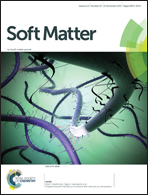Irregular model DNA particles self-assemble into a regular structure†
Abstract
DNA nanoparticles with three-fold coordination have been observed to self-assemble in experiment into a network equivalent to the hexagonal (6.6.6) tiling, and a network equivalent to the 4.8.8 Archimedean tiling. Both networks are built from a single type of vertex. Here we use analytic theory and equilibrium and dynamic simulation to show that a model particle, whose rotational properties lie between those of the vertices of the 6.6.6 and 4.8.8 networks, can self-assemble into a network built from three types of vertex. Important in forming this network is the ability of the particle to rotate when bound, thereby allowing the formation of more than one type of binding motif. The network in question is equivalent to a false tiling, a periodic structure built from irregular polygons, and possesses 40 particles in its unit cell. The emergence of this complex structure, whose symmetry properties are not obviously related to those of its constituent particles, highlights the potential for creating new structures from simple variants of existing nanoparticles.



 Please wait while we load your content...
Please wait while we load your content...